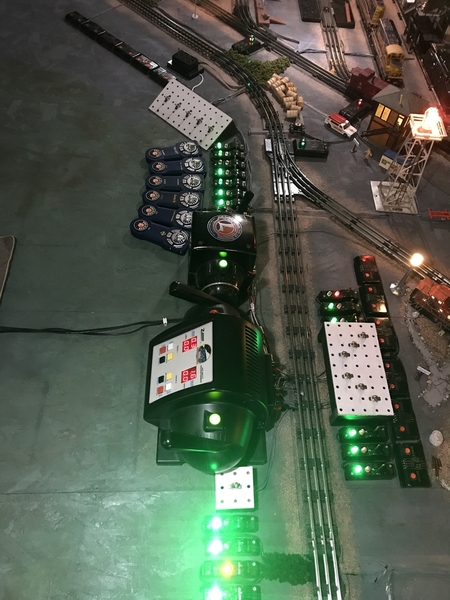Hi all,
I have a pretty simple attic layout. Two districts powered by a Z4000 (about 400’ of track including sidings), no command except LC+. For accessories, I use post A on a ZW for constant voltage to the 18 022s and 12 UCS. All bulbs in the 022s and 022c’s are LED. Post B is dedicated to my 282 crane and post C to my two 262 crossing gates. Post D is for lighting only. 3/4 of my lighting is LED but I do have some incandescent bulbs in a few of my postwar floodlight towers (4 banks of 8 bulbs on two 194 towers). I am using 14ga wire for all my track power and 16ga for the 022 daisy chain and the UCS wiring, quite small gauge for the lighting, probably 22ga or so.
If the ZW is on without the Z4000 and so obviously not running trains, the ZW stays pretty cool. However once I turn on the Z4000 and start running trains, the ZW gets pretty warm after a half hour or so. After an hour it is hot, but not burning hot.
Anyway, I put my multimeter on some of the accessories at various points of the layout and found between 1 and 2 volts of voltage drop on both the A and D circuits (ZW).
My question is, does this seem normal?
A) I don’t feel like there is that much draw that should be causing so much voltage drop.
B) Does the frequent switching of the 022s and action of the 262s while running trains draw enough current to cause the ZW to heat up like that?
C) When I disconnect the load from the ZW, the voltage matches the numbers on the bezel of the transformer. If my multimeter is reading 12v at the farthest 022 when the transformer is set at 14v, is it safe to assume the switch is only seeing 12v? If so, that may account for some of the poor performance I have been experiencing with the 022s.
Thanks for your thoughts on this. Perhaps it’s time to replace the old ZW?
Kevin
controls
looking west
looking center 
looking east











